
Anthemis is a genus of aromatic flowering plants in the family Asteraceae, closely related to Chamaemelum, and like that genus, known by the common name chamomile; some species are also called dog-fennel or mayweed. Anthemis are native to the Mediterranean region and southwest Asia east to Iran. A number of species have also become naturalized in the United Kingdom and other parts of the world.
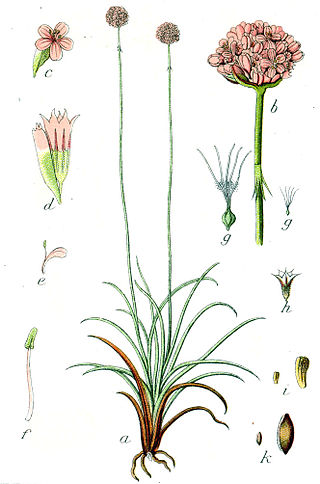
Armeria is a genus of flowering plants. These plants are sometimes known as "lady's cushion", "thrift", or "sea pink". The genus counts over a hundred species, mostly native to the Mediterranean, although Armeria maritima is an exception, being distributed along the coasts of the Northern Hemisphere, including Ireland, parts of the United Kingdom such as Cornwall, and the Pembrokeshire Coast National Park in Wales.

Cynanchica pyrenaica, commonly known as squinancywort or squincywort, is a species of flowering plant in the family Rubiaceae. Its common name is derived from its former use as a medicinal herb to cure quinsy. It is native to much of southern and central Europe from Spain and Ireland to Russia.

Pewsey Downs is a 305.3 hectare biological Site of Special Scientific Interest on the southern edge of the Marlborough Downs north of Pewsey in Wiltshire, notified in 1951. It includes the Pewsey Downs National Nature Reserve.
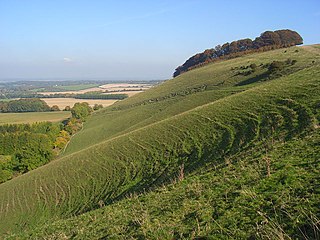
Ham Hill is a hill and area of chalk downland in Wiltshire, England, on the steep banks running alongside the road from the village of Ham to Buttermere, close to the Berkshire border. A biological Site of Special Scientific Interest, notified in 1971, covers 1.5 hectares of the site; this designation is due to the site's species-rich plant and insect communities, which include some rare species. Notable among these is the musk orchid, which has been confirmed at only one other site in Wiltshire.
The Folkestone Downs are an area of chalk downland above Folkestone, where the eastern end of the North Downs escarpment meets the English Channel. Part of the Downs is the Folkestone to Etchinghill Escarpment Site of Special Scientific Interest, designated for its geological and biological interest.

Kohautia is a genus of flowering plants in the family Rubiaceae. They are native to tropical areas of Asia, Africa, and Madagascar. Thirty-one species are known. The type species for the genus is Kohautia senegalensis.

Cynanchica, commonly known as woodruff, is a genus of flowering plants in the family Rubiaceae. It contains 73 species and has a wide distribution area from Europe, northern Africa, the Middle East and central Asia. The genus was erected in 2020 to accommodate species split from the genus Asperula.

Cynanchica aristata, commonly known as woodruff, is a deciduous species of perennial groundcover, and a flowering plant in the family Rubiaceae. It is native to Morocco, Libya, Algeria, Tunisia, Azerbaijan, Georgia, Armenia, Greece, Bulgaria, Albania, Serbia, North Macedonia, Croatia, Italy, Austria, Switzerland, France, Spain, and Portugal.
Cynanchica breviflora is a species of flowering plant in the family Rubiaceae. It was described in 1849 and is endemic to Syria.
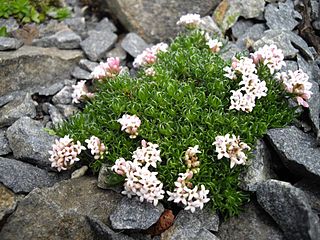
Cynanchica gussonei, also known as alpine woodruff, is a deciduous species of perennial groundcover, and a flowering plant in the family Rubiaceae. It was first described in 1831 and is endemic to Sicily.
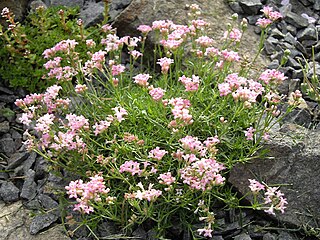
Cynanchica lilaciflora is a species of flowering plant in the family Rubiaceae.
Cynanchica mungieri is a species of flowering plant in the family Rubiaceae.

Cynanchica nitida is a species of flowering plant in the family Rubiaceae. It was first described in 1806 and is endemic to Turkey.

Cynanchica rupicola is a species of flowering plant in the coffee family Rubiaceae. It was first described in 1852 and is endemic to France and Italy.
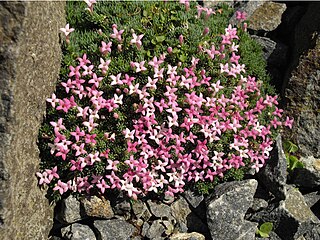
Cynanchica sintenisii is a species of flowering plant in the family Rubiaceae.
Cynanchica abbreviata, commonly known as woodruff, is a species of flowering plant in the family Rubiaceae that is endemic to Naxos and Amorgos in Greece. It was first formally described in 1901 by Eugen von Halácsy who gave it the name Asperula lutea var. abbreviata in Conspectus Florae Graecae. In 1943, Karl Heinz Rechinger raised the variety to species status as Asperula abbreviata in Denkschriften der Kaiserlichen Akademie der Wissenschaften / Mathematisch-Naturwissenschaftliche Classe. In 2020, it was reclassified into the newly erected genus Cynanchica.
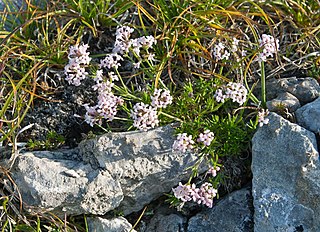
Cynanchica abchasica, commonly known as woodruff, is a deciduous species of perennial groundcover, and a flowering plant in the family Rubiaceae. It is endemic to Transcaucasus, and was first named by V.I Krecz. In 2020, it was reclassified into the newly erected genus Cynanchica.
Cynanchica accrescens, commonly known as woodruff, is a deciduous species of perennial groundcover, and a flowering plant in the family Rubiaceae. It is endemic to Transcaucasus and was first named by Klokov.
Cynanchica affinis is a deciduous species of perennial groundcover, and a flowering plant in the family Rubiaceae. It is endemic to north-eastern Turkey and the Transcaucasus, and was first named by Boiss. & A.Huet.














